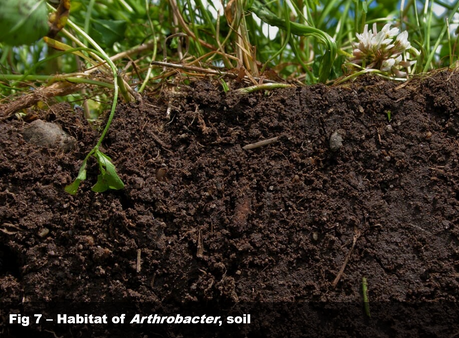CORYNEFORM BACTERIA

ARTHROBACTER
INTODUCTION TO ARTHROBACTER
At present the genus Arthrobacter contains around 70 recognised species, all of which are Gram-positive, catalase positive, highly proteolytic and non-spore forming, (19). Most species of Arthrobacter are non-motile, but some can be weakly motile by having one subpolar or a few lateral flagella, (28). Members of the genus can be characterised by their unique growth cycle in which they go from rods to coccus, and then undergo reversion back to rods, (19). After division, Arthrobacter can be seen to be V-shaped. This is due to a method of division termed snapping division where the outer layer of the cell wall ruptures on one side. Arthrobacter are generally considered obligate aerobes, however two species: A. globiformis and A. nicotianae have been shown to be facultative anaerobes, (23).

CELL MORPHOLOGY
One of Arthrobacter’s key features is its unusual growth cycle, in which they are rods during exponential growth (log phase) and cocci in their stationary phase (lag phase). If cells are then transferred to fresh medium while in coccoid form, they produce outgrowths, becoming irregular rods again, as they return to log phase, (29). In a batch culture with the appropriate media, Arthrobacter are only in the rod form for a few hours in which the physiology and environment of the organism is described as being in a dynamic state, (30). The morphology of Arthrobacter is related to specific growth rate and it has been shown that the change

Fig 6: Coccoid to rod reversion in A. globiformis
from rods does not require a specific inducer, (30). When Arthrobacter are in their coccoid form, they are very resistant to desiccation and starvation, despite the organism’s inability to form spores, (3).
HABITAT
Species of Arthrobacter can be found in various habitats, which include many different types of soil, on plant surfaces, and in sewage water, (28). They can also be located in a number of extreme environments, for example in Antarctic ice, radioactive environments, subterranean cave silts, (19), glacier silts, (31) and sites which are contaminated by toxic chemicals, (32). The genus was also isolated from manganese nodules, (33). The fact that Arthrobacter can be found in a wide range of environments is due to its ability to survive long periods in stressful conditions such as starvation, temperature shifts, toxic chemicals and change in oxygen concentrations.
Ecology



